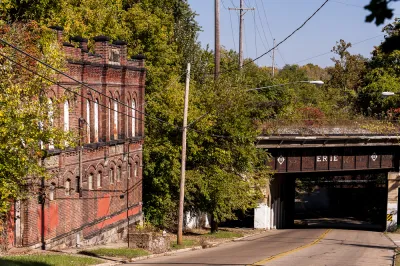Managed decline assumes that struggling cities will continue to struggle indefinitely. Is there a better way to plot neighborhood stabilization?

Jason Segedy, director of planning and urban development in the city of Akron, writes a dissent of the "managed decline" policies that gained traction in Rust Belt cities like Detroit as it struggled with the consequences of a shrinking population.
Segedy acknowledges the argument "that managed decline is a pragmatic approach to present-day economic realities." There is also an argument, adds Segedy, that managed decline is a fatalistic, self-fulfilling prophecy.
Are cities simply hapless victims, subject to the whims of the fates? Or can wise leadership, creativity, and strategic planning create demand to live in a place, and bring about a reversal of fortunes? People who remember Brooklyn in 1977, or East Berlin in 1983, would probably agree that places can change in dramatic and unexpected ways, and that it is sometimes darkest before the dawn.
In fact, argues Segedy, Detroit never actually threw its full bureaucratic weight behind managed decline, and many of its successes now result from embracing the slogan of Mayor Mike Guggan's administration: "Every neighborhood has a future."
To elaborate on the argument against managed decline, Segedy points out a few key areas that offer optimism in Rust Belt cities—and not just Detroit. Opportunities include for new housing, adaptive reuse, and creating incentives for new demand (beyond job creation).
FULL STORY: Housing First: Rejecting Managed Decline in the Rust Belt

National Parks Layoffs Will Cause Communities to Lose Billions
Thousands of essential park workers were laid off this week, just before the busy spring break season.

Retro-silient?: America’s First “Eco-burb,” The Woodlands Turns 50
A master-planned community north of Houston offers lessons on green infrastructure and resilient design, but falls short of its founder’s lofty affordability and walkability goals.

Delivering for America Plan Will Downgrade Mail Service in at Least 49.5 Percent of Zip Codes
Republican and Democrat lawmakers criticize the plan for its disproportionate negative impact on rural communities.

Test News Post 1
This is a summary

Test News Headline 46
Test for the image on the front page.

Balancing Bombs and Butterflies: How the National Guard Protects a Rare Species
The National Guard at Fort Indiantown Gap uses GIS technology and land management strategies to balance military training with conservation efforts, ensuring the survival of the rare eastern regal fritillary butterfly.
Urban Design for Planners 1: Software Tools
This six-course series explores essential urban design concepts using open source software and equips planners with the tools they need to participate fully in the urban design process.
Planning for Universal Design
Learn the tools for implementing Universal Design in planning regulations.
EMC Planning Group, Inc.
Planetizen
Planetizen
Mpact (formerly Rail~Volution)
Great Falls Development Authority, Inc.
HUDs Office of Policy Development and Research
NYU Wagner Graduate School of Public Service




























